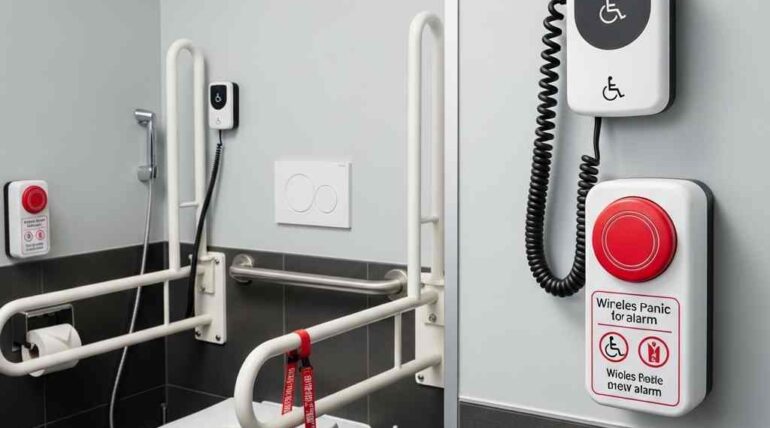
In any public building, hospital, or accessible facility, ensuring the safety of disabled individuals is a critical responsibility. One of the most essential safety features for accessibility is the wireless panic alarm in disabled toilets. These alarm systems allow individuals with mobility challenges or medical conditions to summon help quickly and easily in an emergency.
Let’s explore what these systems are, how they work, and why every accessible toilet should be equipped with an emergency pull cord alarm.
What is a wireless panic alarm in a disabled toilet?
A wireless panic alarm is a battery-operated or mains-powered device that enables someone inside a disabled toilet to call for help instantly during an emergency. Unlike traditional wired systems, wireless panic alarms are easy to install and do not require complicated infrastructure.
Most systems include:
- A pull cord alarm installed near the toilet and/or sink
- A wireless receiver installed at a nearby staff station or hallway
- A visual and audible alert system, often with a flashing light and loud buzzer
- A reset button inside the toilet cubicle for easy cancellation
These alarms are critical in situations where a user falls, feels unwell, or cannot reach the door for assistance.
Why emergency pull cord alarms are important?
The emergency pull cord alarm in a disabled toilet is not just a safety device—it is a necessity. It ensures that individuals with physical or sensory impairments can live and move independently, with the assurance that help is just a pull away.
Here are some key benefits:
- Quick response to falls or medical emergencies
- Increased user confidence and peace of mind
- Compliance with accessibility regulations and safety codes
- Improved safety in care homes, hospitals, malls, and offices
Where are these alarms most commonly used?
You’ll find disabled toilet alarm systems in places like:
- Hospitals and medical centers
- Shopping malls and supermarkets
- Government buildings
- Airports and transportation hubs
- Schools and universities
- Hotels and commercial complexes
Installing a toilet emergency alarm for disabled users is not just a best practice—it is a legal and ethical requirement in many countries.
How Do Wireless Toilet Alarm Systems Work?
A typical wireless toilet alarm system includes:
- Pull Cord: Easily reachable from both the toilet seat and the floor in case of a fall.
- Wireless Transmitter: Sends a signal to the alert system when the cord is pulled.
- Receiver or Indicator Panel: Alerts staff or caregivers with flashing lights and/or buzzing sound.
- Reset Unit: Allows the user or caregiver to cancel the alert once help arrives.
Because these systems are wireless, installation is fast and cost-effective with minimal disruption.
Key F]features to look for:
When selecting a panic alarm for a disabled washroom, consider these features:
- Long-range signal transmission
- Battery backup or low battery alert
- Loud and clear audio signals
- Visual indicators (flashing lights)
- Durable and waterproof pull cords
- Easy reset buttons for user control
- Compatibility with multiple receivers
These features ensure the system is both reliable and user-friendly, especially in emergencies.
Who needs these systems?
- Wheelchair users
- Elderly persons with limited mobility
- People with chronic medical conditions
- Individuals with balance or strength issues
- Patients recovering from surgery or illness
By installing a bathroom emergency alarm for elderly and disabled individuals, you not only protect lives but also promote independence and dignity.
Complying with accessibility standards
Many countries have laws or building codes that require accessible washrooms to be equipped with an emergency assistance alarm. These systems must be:
- Reachable from the toilet and the floor
- Clearly marked with signage
- Connected to a monitored location
- Regularly tested and maintained
Failure to meet these standards can result in legal penalties and puts vulnerable users at risk.
Conclusion: Prioritize accessibility and safety
Installing a wireless panic alarm in disabled toilets is one of the simplest and most effective ways to ensure user safety. These systems offer fast emergency response, peace of mind, and compliance with legal standards. Whether it’s a pull cord alarm for a public washroom or a wireless toilet alarm system in a care facility, the value they provide is undeniable.









